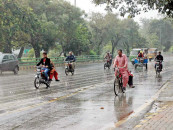Anomalies in Pak-Africa bilateral trade regime
Pakistan’s trade volume with Africa has reached the historic level of $6 billion in 2021

Pakistan’s trade volume with Africa has reached the historic level of $6 billion in 2021. However, trade balance has heavily been tilted in the favour of Africa since 2015. According to ITC’s Trademap, imports were recorded at $4.5 billion in 2021 as opposed to $2.6 billion last year, posting a robust growth of 70.5%. However, sluggish growth in exports can be seen as it only expanded from $1.4 billion to $1.48 billion over the same period.
The compelling needs for export diversification including both market and product diversification have been discussed extensively under almost all government regimes. Multiple attempts have been made to broaden the export base. Pakistan’s Ministry of Commerce under SRO 1062 (I)/2017 has notified an additional 2% duty drawback on exports to non-traditional markets which include 58 African, 40 Latin American, 10 Commonwealth Independent States, 27 Oceania, and 8 Non-EU European countries. Africa appears to be one of the most lucrative markets, especially for non-traditional export products from Pakistan. Government engagements to bolster trade ties with Africa have witnessed a visible surge in exports of non-traditional export items including electric fans, tractors, rickshaws, ethanol, Himalayan pink salt, etc.
Africa is the second largest continent in terms of population after Asia with the highest continent-wise population growth rate of 2.7%, according to World Bank. To reinvigorate trade ties with Africa, the then Secretary Commerce Mohammad Younus Dagha launched the ambitious ‘Look Africa’ policy in 2017 in an attempt toward geographical and product diversification of exports. Under the policy, the top 10 African nations based on their economic size — Nigeria, Kenya, South Africa, Morocco, Algeria, Egypt, Sudan, Ethiopia, Tanzania and Angola — were identified to enhance trade. In addition, Preferential Trade Agreements (PTA) with three African trading blocs — SACU, ECOWAS and EAC — were among the key aspects of the policy. The Trade Development Authority of Pakistan was designated to provide a special subsidy of 80% for Pakistani companies to encourage their participation in trade fairs in Africa. A series of Pakistan-Africa Trade & Development Conference (PATDC) was also part of the policy for which the first PATDC was held in January 2020 in Nairobi, the second was held in Lagos in November 2021, and a third is going to be held in Johannesburg by the end of November 2022.
Although the Look Africa policy is an important milestone achieved on domestic grounds, much needs to be done on the foreign trade policy front. A careful analysis allows detection of several anomalies in the bilateral trade regime. South African authorities slapped antidumping duties of 14-77% on major Pakistani cement exporters. As a consequence, Pakistan lost $67 million of Portland Cement exports to Africa between 2015 and 2016. On the other hand, Pakistan has now emerged as a major export destination for South African coal exporters with the annual demand for imported coal worth $1 billion to 1.5 billion since 2017. Likewise, Pakistan, being the world’s largest importer of black fermented tea, imports around 87% of tea from Kenya at an average tariff of 11%. However, non-basmati rice which is Pakistan’s prime export product to Kenya faces an average tariff of 35% and most of the time is subjected to stringent scrutiny. ‘Ugali’, a staple diet of indigenous people of East Africa, is prepared from non-basmati rice. Similar anomalies can be traced in other African economies such as Nigeria, Egypt and Ethiopia.
Aggressive negotiations should be made with African authorities in order to seek a level-playing field. Besides taking measures to minimise anti-export biases, the government must provide credit guarantee schemes similar to peer countries such as India and China in order to hedge much-elevated credit and exchange rate risk exposures. In addition, aside from effective negotiation of PTAs with the aforementioned trade blocs, strategic entries need to be made in countries such as Ethiopia and Kenya which are currently non-signatories of common external tariffs under their respective trade blocs.
Published in The Express Tribune, November 12th, 2022.
Like Opinion & Editorial on Facebook, follow @ETOpEd on Twitter to receive all updates on all our daily pieces.




1729685382-0/Untitled-design-(57)1729685382-0-208x130.webp)









COMMENTS
Comments are moderated and generally will be posted if they are on-topic and not abusive.
For more information, please see our Comments FAQ